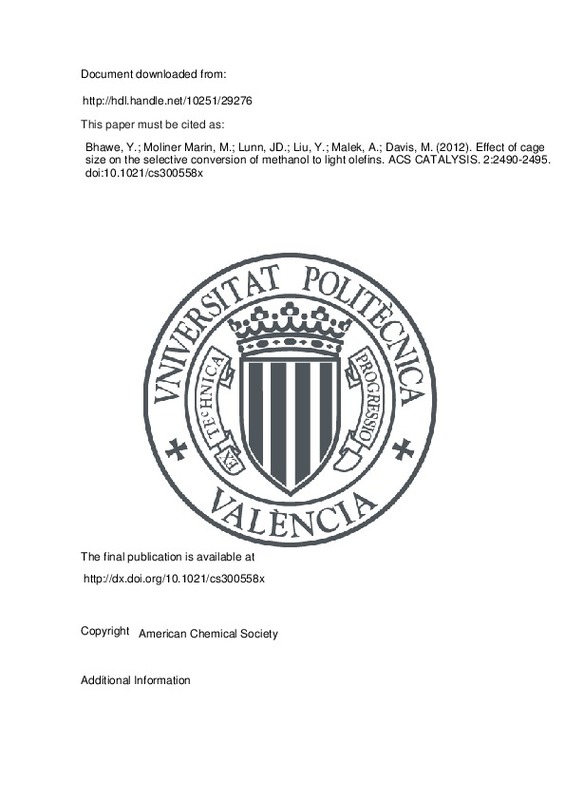JavaScript is disabled for your browser. Some features of this site may not work without it.
Buscar en RiuNet
Listar
Mi cuenta
Estadísticas
Ayuda RiuNet
Admin. UPV
Effect of cage size on the selective conversion of methanol to light olefins
Mostrar el registro sencillo del ítem
Ficheros en el ítem
| dc.contributor.author | Bhawe, Yashodhan
|
es_ES |
| dc.contributor.author | Moliner Marin, Manuel
|
es_ES |
| dc.contributor.author | Lunn, Jonathan D.
|
es_ES |
| dc.contributor.author | Liu, Yu
|
es_ES |
| dc.contributor.author | Malek, Andrzej
|
es_ES |
| dc.contributor.author | Davis, Mark
|
es_ES |
| dc.date.accessioned | 2013-05-29T10:42:23Z | |
| dc.date.issued | 2012-10 | |
| dc.identifier.issn | 2155-5435 | |
| dc.identifier.uri | http://hdl.handle.net/10251/29276 | |
| dc.description.abstract | [EN] Zeolites that contain eight-membered ring pores but different cavity geometries (LEV, CHA, and AFX structure types) are synthesized at similar Si/Al ratios and crystal sizes. These materials are tested as catalysts for the selective conversion of methanol to light olefins. At 400 degrees C, atmospheric pressure, and 100% conversion of methanol, the ethylene selectivity decreases as the cage size increases. Variations in the Si/Al ratio of the LEV and CHA show that the maximum selectivity occurs at Si/Al = 15-18. Because lower Si/Al ratios tend to produce faster deactivation rates and poorer selectivities, reactivity comparisons between frameworks are performed with solids having a ratio Si/Al = 15-18. With LEV and AFX, the data are the first from materials with this high Si/Al. At similar Si/Al and primary crystallite size, the propylene, selectivity for the material with the CHA structure exceeds those from either the LEV or AFX structure. The AFX material gives the shortest reaction lifetime, but has the lowest amount of carbonaceous residue after reaction. Thus, there appears to be an intermediate cage size for maximizing the production of light olefins and propylene selectivities equivalent to or exceeding ethylene selectivities. | es_ES |
| dc.description.sponsorship | The authors thank The Dow Chemical Company for financial support of this work. The authors also thank Chengli Zu and Suzanne Lehr of Analytical Sciences at The Dow Chemical Company for their assistance with the GC/MS work. | |
| dc.language | Inglés | es_ES |
| dc.publisher | American Chemical Society | es_ES |
| dc.relation.ispartof | ACS CATALYSIS | es_ES |
| dc.rights | Reserva de todos los derechos | es_ES |
| dc.subject | Methanol-to-olefins | es_ES |
| dc.subject | Zeolite | es_ES |
| dc.subject | CHA | es_ES |
| dc.subject | LEV | es_ES |
| dc.subject | AFX | es_ES |
| dc.title | Effect of cage size on the selective conversion of methanol to light olefins | es_ES |
| dc.type | Artículo | es_ES |
| dc.embargo.lift | 10000-01-01 | |
| dc.embargo.terms | forever | es_ES |
| dc.identifier.doi | 10.1021/cs300558x | |
| dc.rights.accessRights | Abierto | es_ES |
| dc.contributor.affiliation | Universitat Politècnica de València. Instituto Universitario Mixto de Tecnología Química - Institut Universitari Mixt de Tecnologia Química | es_ES |
| dc.description.bibliographicCitation | Bhawe, Y.; Moliner Marin, M.; Lunn, JD.; Liu, Y.; Malek, A.; Davis, M. (2012). Effect of cage size on the selective conversion of methanol to light olefins. ACS CATALYSIS. 2:2490-2495. doi:10.1021/cs300558x | es_ES |
| dc.description.accrualMethod | S | es_ES |
| dc.relation.publisherversion | http://dx.doi.org/10.1021/cs300558x | es_ES |
| dc.description.upvformatpinicio | 2490 | es_ES |
| dc.description.upvformatpfin | 2495 | es_ES |
| dc.type.version | info:eu-repo/semantics/publishedVersion | es_ES |
| dc.description.volume | 2 | es_ES |
| dc.relation.senia | 237723 | |
| dc.contributor.funder | Dow Chemical Company |







![[Cerrado]](/themes/UPV/images/candado.png)

